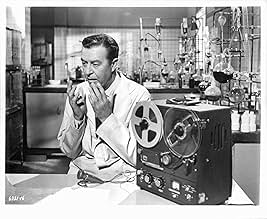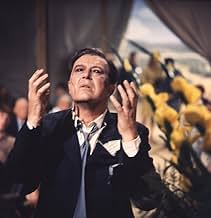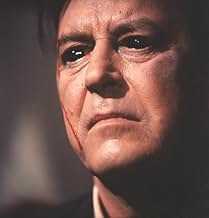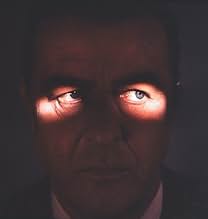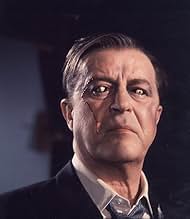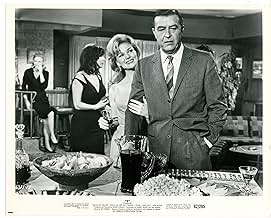AVALIAÇÃO DA IMDb
6,6/10
8,7 mil
SUA AVALIAÇÃO
Adicionar um enredo no seu idiomaAn ambitious scientist invents an eye drop formula that grants him X-ray vision, but his new powers have disastrous consequences.An ambitious scientist invents an eye drop formula that grants him X-ray vision, but his new powers have disastrous consequences.An ambitious scientist invents an eye drop formula that grants him X-ray vision, but his new powers have disastrous consequences.
- Direção
- Roteiristas
- Artistas
- Prêmios
- 2 indicações no total
Diana Van der Vlis
- Dr. Diane Fairfax
- (as Diana van der Vlis)
Budd Albright
- Dance sequence
- (não creditado)
Leon Alton
- Casino Patron
- (não creditado)
Morris Ankrum
- Mr. Bowhead
- (não creditado)
Benjie Bancroft
- Dealer
- (não creditado)
George DeNormand
- Medical Board Member
- (não creditado)
John Dierkes
- Preacher
- (não creditado)
Bobby Gilbert
- Man Outside Office
- (não creditado)
Stuart Hall
- Casino Patron
- (não creditado)
Kathryn Hart
- Mrs. Mart
- (não creditado)
Ed Haskett
- Casino Patron
- (não creditado)
Jonathan Haze
- Heckler
- (não creditado)
Harvey Jacobson
- Casino Boss
- (não creditado)
Vicki Lee
- Young Girl Patient
- (não creditado)
Avaliações em destaque
RELEASED IN 1963 and directed by Roger Corman, "X: The Man with the X-Ray Eyes" chronicles events in Los Angeles when a doctor (Ray Milland) develops a formula that grants x-ray vision, which derails his career and forces him to join a carnival, using his new power to make a living. Diana Van der Vlis plays his disciple while Don Rickles is on hand as a carnival barker.
The early 60's vibe is to die for, but the beginning is rather dull. Things perk up at an adult party where the aging doctor tries to keep hip and eventually sees everyone nakkid (lol). The carnival sequence and what it leads into are arguably the best parts, although the Vegas and tent revival episodes have their attractions. The movie scores meh on the female front, but Lorrie Summers and Cathie Merchant have small parts.
THE MOVIE RUNS 1 hour 19 minutes and was shot in Los Angeles, California & Las Vegas, Nevada. WRITERS: Robert Dillon and Ray Russell. ADDITIONAL CAST: Harold J. Stone and John Hoyt play colleagues of the doctor.
GRADE: B-
The early 60's vibe is to die for, but the beginning is rather dull. Things perk up at an adult party where the aging doctor tries to keep hip and eventually sees everyone nakkid (lol). The carnival sequence and what it leads into are arguably the best parts, although the Vegas and tent revival episodes have their attractions. The movie scores meh on the female front, but Lorrie Summers and Cathie Merchant have small parts.
THE MOVIE RUNS 1 hour 19 minutes and was shot in Los Angeles, California & Las Vegas, Nevada. WRITERS: Robert Dillon and Ray Russell. ADDITIONAL CAST: Harold J. Stone and John Hoyt play colleagues of the doctor.
GRADE: B-
A very thoughtful, engrossing, flawed film from superhuman director/producer Roger Corman. Yep, it has some problems, most primarily dealing with a limited budget. But what it lacks in dollars it has in heart and its ability to make you think about what we are missing out seeing with our vision. I am not sure that much, or even any, scientific creedence can be given to the idea behind the experiments of Dr. Xavier James and his search to see beyond what normal vision allows. Ray Milland gives a fine performance as the obsessed man out to continue his experiments even if they involve using himself as the human guinea pig. Some of the scenes and dialogue are a bit hokey by today's standards but most fit the film very nicely. The scene with Milland at a party is a real hoot and great comedic relief. I also loved the end to the film but thought it could have been plucked out a little longer. The effects are very sparse and the only ones I really thought were any good were the ones used to highlight Milland's eyes through the film. The film boasts a fine cast of stalwart sci-fi/Corman people such as Morris Ankrum, Dick Miller, Jonathan Haze, and Barboura Morris, as well as a young(and obviously talented) Don Rickles. Definitely try to see your way to seeing this film.
This was the typically-hokey-but fun Roger Corman film but one that keeps your interest most the way and at least stars a famous classic-era actor: Ray Milland. One actually wonders what an actor of Milland's status would doing in a B Grade B-type sci-fi movie like this. For someone who had admired Milland's work for many years, it just seems odd for me to see him in a small-budget film. Maybe things got tough for him near the end of his career and he would take most any role. I don't know, and I'm not judging.....just curious why he took this role. I do know having him in the movie elevates it and the dialog isn't as cheesy as one would expect in a 1950-ish sci-fi horror story made in the '60s.
Comedian Don Rickles playing a greedy criminal guy was another odd cast selection, but, he, too, was fun to watch.
Corman was smart to keep this at a respectable 79 minutes. Had it gone on longer, it would have started to drag. It would be interesting to see this film done with today's special-effects.
Comedian Don Rickles playing a greedy criminal guy was another odd cast selection, but, he, too, was fun to watch.
Corman was smart to keep this at a respectable 79 minutes. Had it gone on longer, it would have started to drag. It would be interesting to see this film done with today's special-effects.
This is one of my favorite Roger Corman flicks. Brisk pace and many surprises. Don Rickles as a ruthless carny exploiteer is one of them. Milland wears more and more ridiculous sunglasses as the movie progresses.
Seriously, this is one of Don Rickles' best performances -- it shows that he could have gone in a totally different direction than he followed for most of his career (as an "insult comedian") if he had wanted to. I imagine that his appearance in the film had something to do with his contract with AIP, but I still think it's a bit of VERY inspired casting (regardless of the financial reasons that may have been behind it).
Milland is also excellent in the type of role that suits him to a T... he gets to be kind of a Dr. Frankenstein here, convinced he's doing good for humanity but making himself into a monster in the process.
A memorable story with a meaning.
Seriously, this is one of Don Rickles' best performances -- it shows that he could have gone in a totally different direction than he followed for most of his career (as an "insult comedian") if he had wanted to. I imagine that his appearance in the film had something to do with his contract with AIP, but I still think it's a bit of VERY inspired casting (regardless of the financial reasons that may have been behind it).
Milland is also excellent in the type of role that suits him to a T... he gets to be kind of a Dr. Frankenstein here, convinced he's doing good for humanity but making himself into a monster in the process.
A memorable story with a meaning.
To this writer, the film is Roger Corman's best entry into sci-fi. Many of his 50s efforts hold a certain campy charm, with their low-budget effects - and this film is similar in that regard. It does not dwell on the effects, in fact some of them are rather poor. What it does have in its favor is a tight screenplay that gets into the story quickly, as will the viewer - and it's engrossing enough and the characters interesting enough that one stays involved through the episodic story.
What it has most in its favor is an excellent performance from Ray Milland, then in his last days being top-billed, and he milks it for all that it's worth. In some scenes Corman goes for a direct close-up and Milland's facial reactions indicate that he took the the role in a small-budget/tight schedule film with all the enthusiasm that he did in one of his roles for Alfred Hitchcock ("Dial M For Murder") or Fritz Lang ("Ministry of Fear"). Smooth, refined, but a man of immediate action if necessary, Milland's Dr. Xavier is not your usual mad scientist. As with Claude Rains in "The Invisible Man" or Al Hedison in "The Fly" he's the scientist who made the mistake of being his own subject.
Occasionally Corman goes for the cheap gag (the party sequence, where Xavier examines the guests sans attire - but inoffensive in a typical 60s approach), but the carnival scenes and the basement healer scenes show a maturity to Corman's direction, and these scenes are greatly helped by the performance of Don Rickles. He's as sleazy as one can get and admits that if he had the power, he would use it to see "all the undressed women my poor eyes can stand" and you believe it. A scene where Milland confronts other carnival workers who are speculating on his "power" shows the doctor to be both introspective and world weary at the same time. At this point even he does not know what to do with his ability, but Rickles' suggestion of setting up a site to "heal" others leads to the film's most revealing and almost poetic sequence. Xavier's original intention was to help the ill, but his implication in an accidental murder led him to seek refuge in the carnival Richard Kimble-style.
Diana Van Der Vlis does well with her underwritten role in which at one point she's rather quickly dropped, and then resurfaces rather conveniently later in the story - to no great effect. This was only her second feature film, though she had done a number of TV guest shots. Although half Milland's age, she seems more mature than her 28 years and they make a believable pair. A bonus is the appearance of a number of veterans in brief roles - John Hoyt, Harold J. Stone, John Dierkes and Morris Ankrum, as well as Corman stalwart Dick Miller. Miller shares his scenes with Jonathan Haze, whom it appears was getting the cheapest rate Corman could pay as he has no lines at all. He was rather bitter about this as he revealed in an interview years later.
Floyd Crosby's cinematography belies the small budget - only $300,000 and a shooting schedule of about three weeks. According to Corman they did rehearse a bit more than usual - and in the finished product it shows. He claims he even went as high as four takes, which may not exactly put him in William Wyler or Stanley Kubrick territory, but it's a far cry from what he'd do in the 50s. Les Baxter contributes what may be my favorite of his scores, fully complimentary to the action on screen without overwhelming it.
There's a bit of controversy over the ending - some attribute an extra line of dialog that never appeared in any print that I've seen, but it is still one of the most surprising endings of any sci-fi film since "The Incredible Shrinking Man." That it won the top prize at the Trieste Science Fiction Film Festival would be enough for one to be curious enough to see it even this many years later - that it has held up so well over 40 years points to that award's validity.
What it has most in its favor is an excellent performance from Ray Milland, then in his last days being top-billed, and he milks it for all that it's worth. In some scenes Corman goes for a direct close-up and Milland's facial reactions indicate that he took the the role in a small-budget/tight schedule film with all the enthusiasm that he did in one of his roles for Alfred Hitchcock ("Dial M For Murder") or Fritz Lang ("Ministry of Fear"). Smooth, refined, but a man of immediate action if necessary, Milland's Dr. Xavier is not your usual mad scientist. As with Claude Rains in "The Invisible Man" or Al Hedison in "The Fly" he's the scientist who made the mistake of being his own subject.
Occasionally Corman goes for the cheap gag (the party sequence, where Xavier examines the guests sans attire - but inoffensive in a typical 60s approach), but the carnival scenes and the basement healer scenes show a maturity to Corman's direction, and these scenes are greatly helped by the performance of Don Rickles. He's as sleazy as one can get and admits that if he had the power, he would use it to see "all the undressed women my poor eyes can stand" and you believe it. A scene where Milland confronts other carnival workers who are speculating on his "power" shows the doctor to be both introspective and world weary at the same time. At this point even he does not know what to do with his ability, but Rickles' suggestion of setting up a site to "heal" others leads to the film's most revealing and almost poetic sequence. Xavier's original intention was to help the ill, but his implication in an accidental murder led him to seek refuge in the carnival Richard Kimble-style.
Diana Van Der Vlis does well with her underwritten role in which at one point she's rather quickly dropped, and then resurfaces rather conveniently later in the story - to no great effect. This was only her second feature film, though she had done a number of TV guest shots. Although half Milland's age, she seems more mature than her 28 years and they make a believable pair. A bonus is the appearance of a number of veterans in brief roles - John Hoyt, Harold J. Stone, John Dierkes and Morris Ankrum, as well as Corman stalwart Dick Miller. Miller shares his scenes with Jonathan Haze, whom it appears was getting the cheapest rate Corman could pay as he has no lines at all. He was rather bitter about this as he revealed in an interview years later.
Floyd Crosby's cinematography belies the small budget - only $300,000 and a shooting schedule of about three weeks. According to Corman they did rehearse a bit more than usual - and in the finished product it shows. He claims he even went as high as four takes, which may not exactly put him in William Wyler or Stanley Kubrick territory, but it's a far cry from what he'd do in the 50s. Les Baxter contributes what may be my favorite of his scores, fully complimentary to the action on screen without overwhelming it.
There's a bit of controversy over the ending - some attribute an extra line of dialog that never appeared in any print that I've seen, but it is still one of the most surprising endings of any sci-fi film since "The Incredible Shrinking Man." That it won the top prize at the Trieste Science Fiction Film Festival would be enough for one to be curious enough to see it even this many years later - that it has held up so well over 40 years points to that award's validity.
Você sabia?
- CuriosidadesTo create the effect of being able to see through a building, the director filmed the building while it was under construction.
- Erros de gravaçãoThe first X-ray that Dr. Xavier quizzes Dr. Fairfax with is a normal chest X-ray. There is no bullet on that film. Bullets show up very well on X-rays.
- Citações
Dr. Diane Fairfax: What do you see?
Dr. James Xavier: The city... as if it were unborn. Rising into the sky with fingers of metal, limbs without flesh, girders without stone. Signs hanging without support. Wires dipping and swaying without poles. A city unborn. Flesh dissolved in an acid of light. A city of the dead.
- Versões alternativasThrough an apparent lab error, some of the 16mm U.S. television syndication prints had the ending credits in Spanish.
- ConexõesEdited into Gli ultimi giorni dell'umanità (2022)
Principais escolhas
Faça login para avaliar e ver a lista de recomendações personalizadas
- How long is X: The Man with the X-Ray Eyes?Fornecido pela Alexa
Detalhes
- Data de lançamento
- País de origem
- Idioma
- Também conhecido como
- X
- Locações de filme
- Queen of Angels Hospital - 2301 Bellevue Avenue, Los Angeles, Califórnia, EUA(Establishing shot of hospital.)
- Empresa de produção
- Consulte mais créditos da empresa na IMDbPro
Bilheteria
- Orçamento
- US$ 250.000 (estimativa)
- Tempo de duração1 hora 19 minutos
- Mixagem de som
- Proporção
- 1.85 : 1
Contribua para esta página
Sugerir uma alteração ou adicionar conteúdo ausente

Principal brecha
By what name was O Homem dos Olhos de Raio-X (1963) officially released in India in English?
Responda

